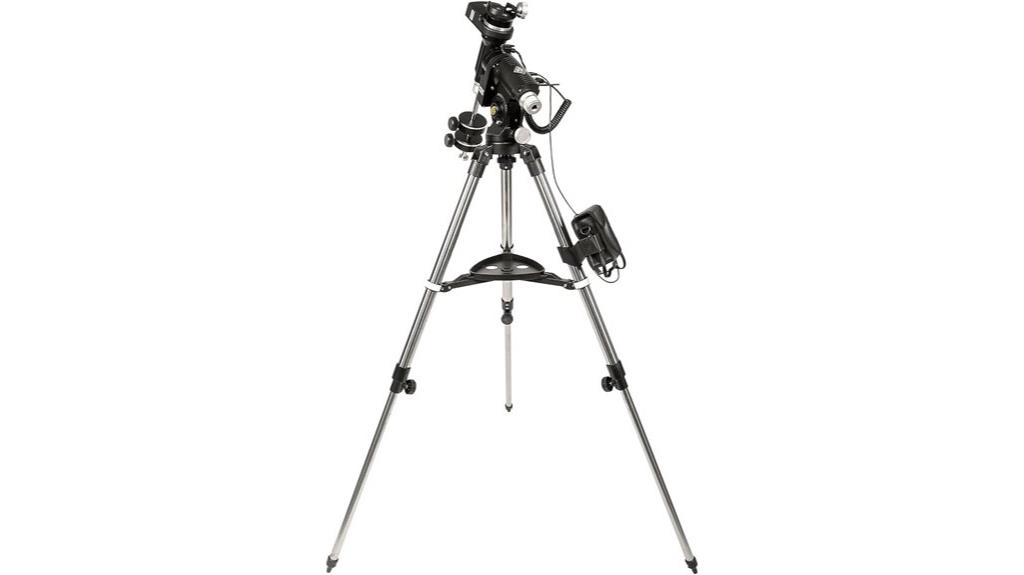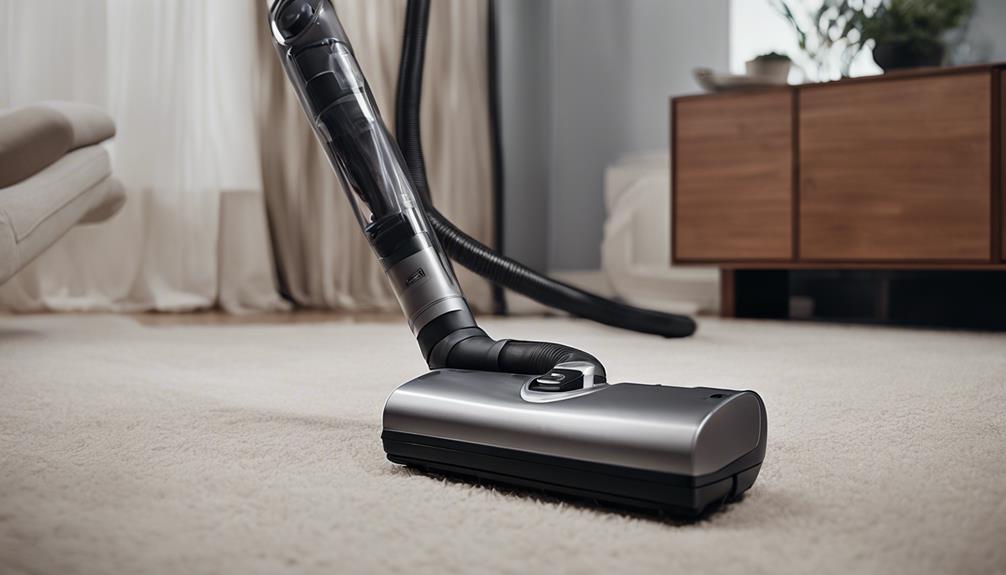If you’re searching for the best equatorial mount with a belt drive in 2025, I recommend considering systems that prioritize precision, quiet operation, and reliable tracking. The iEXOS-100-2 PMC-Eight stands out due to its advanced tech, smooth belt drives, and wireless control, making astrophotography easier and more accurate. It’s portable, easy to set up, and designed for high performance. Keep going to discover more about its features and why it’s the top choice.
Key Takeaways
- The iEXOS-100-2 PMC-Eight offers eight independent CPUs for fast, reliable, and precise tracking in 2025.
- Belt drive systems provide smooth, quiet operation with minimal backlash, enhancing imaging accuracy.
- Wireless control via ExploreStars app allows remote operation across Apple, Android, and Windows devices.
- Its portable design weighing just 20 pounds ensures stability and ease of use in various observing locations.
- For optimal precision, ensure compatibility with your telescope’s payload and proper calibration of the belt drive system.
iEXOS-100-2 PMC-Eight Equatorial Tracker System Tripod and Mount for Astrophotography

If you’re serious about astrophotography, the iEXOS-100-2 PMC-Eight Equatorial Tracker System is a top choice because of its advanced control system and precise tracking capabilities. It features eight independent CPUs, ensuring fast, reliable responsiveness. The quiet stepper motor belt drives and clutched dual-axis worm gears provide smooth, accurate movements. With an intuitive ExploreStars app compatible with Apple, Android, and Windows, you can easily align, navigate, and identify celestial objects wirelessly. Its portable design, weighing just 20 pounds, offers stability and ease of use. Overall, this system combines cutting-edge technology with user-friendly features for outstanding astrophotography results.
Best For: Serious astrophotographers seeking precise, reliable, and user-friendly tracking systems for high-quality celestial imaging.
Pros:
- Advanced control system with eight independent CPUs for fast and reliable responsiveness
- Smooth operation with quiet stepper motor belt drives and clutched dual-axis worm gears
- Wireless control via compatible ExploreStars app across multiple platforms (Apple, Android, Windows)
Cons:
- Relatively heavy at 20 pounds, which may impact portability for some users
- Requires a compatible device and app setup, potentially adding complexity for beginners
- Higher price point reflecting its advanced features, possibly limiting accessibility for casual users
Factors to Consider When Choosing Equatorial Mounts With Belt Drive Systems

When selecting an equatorial mount with a belt drive system, I focus on factors like precision and accuracy to guarantee clear images. I also consider motor noise levels for a quieter observing experience, along with compatibility options to fit my equipment. Finally, ease of setup and power requirements help me choose a reliable and convenient mount for my astronomy sessions.
Precision and Accuracy
Choosing an equatorial mount with a belt drive system is essential for achieving precise and accurate tracking in astrophotography. Belt drives reduce gear backlash, resulting in smoother, more reliable movement that enhances tracking accuracy. Using high-quality belts and stepper motors allows for finer control over the mount’s movements, which is imperative for capturing sharp images of celestial objects. Proper alignment and calibration are essential; even the best mount can’t deliver consistent accuracy without correct setup. Additionally, belt drives operate more quietly and smoothly, minimizing vibrations that can blur images. The dual-axis design enables simultaneous, precise adjustments in right ascension and declination, ensuring your target remains centered. These factors collectively make belt drive mounts a top choice for astrophotographers seeking reliable, high-precision tracking.
Motor Noise Levels
Motor noise levels are a key factor when selecting an equatorial mount with a belt drive system, as quieter operation helps guarantee stable, vibration-free astrophotography sessions. Belt drives typically operate more quietly than gear-driven systems because they produce less meshing noise. The noise level depends on the quality and tension of the belts; higher-quality belts tend to generate less sound. Most modern stepper motors used in belt drives emit minimal noise, especially when combined with sound-dampening components. Maintaining low decibel levels is vital for capturing sharp images without vibrations caused by motor operation. Generally, high-quality belt drive systems stay below 50 dB during use, ensuring a peaceful environment and reducing the risk of image disturbances during long exposures.
Compatibility Options
Selecting an equatorial mount with a belt drive system means verifying it can work seamlessly with your telescope and accessories. Compatibility options include various mounting plates, dovetail types, and payload capacities, so you can match your gear easily. Many belt drive mounts support wireless connectivity via WiFi and Bluetooth, allowing remote operation with smartphones or tablets. These control apps often include star alignment and celestial navigation features, making setup more straightforward. It’s also important to contemplate power options, like AC adapters or portable batteries, for longer sessions. Additionally, check the mount’s size and weight limits to ensure it can reliably support your specific telescope and accessories without strain. Verifying compatibility helps you maximize performance and avoid frustrating adjustments later.
Ease of Setup
When it comes to setting up an equatorial mount with a belt drive system, ease of use is essential for a smooth experience, especially for beginners. Many mounts feature quick-release or clutched axes, making balancing and aligning less time-consuming. Integrated alignment aids, like polar scopes or sight holes, help users perform accurate polar alignment quickly. Wireless connectivity options, such as WiFi or Bluetooth, allow remote control, reducing the need for physical adjustments during setup. Quiet stepper motors enable smooth, unobtrusive adjustments, streamlining initial alignment. Additionally, user-friendly apps and automation features simplify the entire process, guiding users through each step. These design elements considerably reduce setup complexity, making belt drive mounts accessible and convenient for newcomers and seasoned astronomers alike.
Power Requirements
Choosing the right power source is vital for ensuring your belt drive equatorial mount operates smoothly and maintains accurate tracking. The power consumption varies depending on motor size and electronics, typically from a few watts to over ten watts during use. Most mounts are compatible with standard AC adapters or portable power banks, offering flexibility whether you’re observing at home or in the field. Reliable power management is essential; interruptions can cause tracking errors or misalignment, disrupting your astrophotography. Some advanced mounts include battery backups or low-power standby modes, helping you maintain operation during power outages or while traveling. Ensuring a stable, sufficient power supply is key to consistent, precise performance during your astronomical sessions.
Price and Value
Belt drive systems in equatorial mounts often come with a higher price tag due to their advanced components and quieter operation. While the upfront cost is higher, the value they offer is significant—improved tracking accuracy and less gear backlash, which are vital for astrophotography. Higher-priced models may also include faster slewing speeds and better stability, enhancing your observing experience. When evaluating price versus value, consider the durability of the belt materials and the quality of the stepper motors, as these determine longevity and performance. Investing in a mount with a belt drive can save you money in the long run by reducing maintenance needs and minimizing gear wear. Overall, the extra expense can lead to more precise, reliable, and enjoyable astronomy sessions.
Frequently Asked Questions
How Do Belt Drive Systems Improve Tracking Accuracy?
Belt drive systems improve tracking accuracy by reducing backlash and minimizing gear slip, which guarantees smoother, more precise movements. I’ve noticed that belts eliminate the play often found in gear trains, resulting in steadier tracking over long exposures. This consistency is vital for astrophotography, as it keeps my telescope aligned accurately with celestial objects. Overall, belts provide a quieter, more reliable operation that enhances my observational experience.
What Maintenance Is Required for Belt Drive Mounts?
I regularly check the belts for any signs of wear or slack and replace them if needed. I also keep the mount clean, wiping off dust and debris, especially around the belt and gear areas. Lubricating the gears periodically helps maintain smooth operation. Finally, I verify the mount’s firmware is up to date and calibrate it as recommended by the manufacturer to keep tracking precise.
Can Belt Drive Mounts Handle Heavy Astrophotography Setups?
Like a sturdy ship handling rough seas, belt drive mounts can support heavy astrophotography setups if they’re built well. I’ve found that high-quality models with reinforced belts and robust motors can handle substantial loads, but always check the manufacturer’s weight limits. Proper balancing and calibration are key. When chosen carefully, these mounts offer the stability and precision needed for demanding imaging sessions.
Are Belt Drive Equatorial Mounts Suitable for Beginners?
Absolutely, belt drive equatorial mounts are great for beginners! They offer smooth tracking and reduce vibrations, making it easier to learn astrophotography. Plus, many models come with user-friendly features and straightforward setups, helping newcomers get started without feeling overwhelmed. I’ve found that their quiet operation and reliability make them an excellent choice for those just starting out, providing a solid foundation for more advanced astronomy down the line.
How Does Belt Drive Noise Compare to Gear Drives?
Belt drive systems are generally quieter than gear drives, which makes observing sessions more peaceful and enjoyable. I’ve noticed that belt drives produce minimal noise, almost whisper-quiet, whereas gear drives can generate a noticeable grinding or whirring sound, especially at higher speeds. If you value a quiet observing experience, belt drives are definitely the way to go. They help keep your focus sharp without disruptive noise interruptions.
Conclusion
If you’re worried about the complexity of belt drive systems, I assure you, the precision and quiet operation outweigh the initial learning curve. With the right mount, astrophotography becomes smoother and more enjoyable, even for beginners. Don’t let tech fears hold you back—investing in a top-tier equatorial mount with belt drive is a game-changer for capturing stunning celestial images in 2025. Trust me, the results are worth it.









